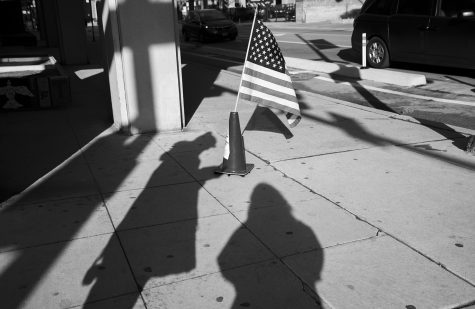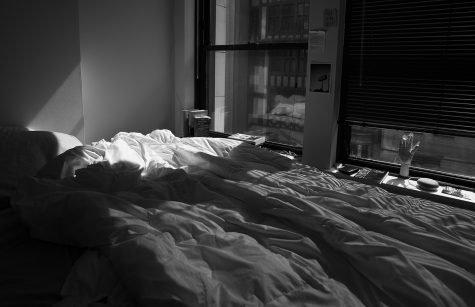Column: Shuttershock, or how it feels for a photographer to lose her creative outlet

I took this photo of myself and fellow photojournalist Justin Anderson during the Illinois primary. It was the last assignment we covered before the Chronicle staff had to move to remote work.
I’ve spent the past week bouncing from my bed to the kitchen to the living room couch and then back to bed. I’ve been walking in a small triangle within my apartment that doesn’t feel like my apartment anymore, but a prison that I’ve jokingly started to call “the cube.” Just like everyone else during this strange time, I’m stuck at home.
It has been a week since I had the difficult conversation with Director of Photography Mike Rundle about whether or not it was practical or moral to send the Chronicle’s photojournalists out on assignment after our advisers told us not to take any undue risks that could jeopardize our health. With that discussion ending in a resigned “no,” and my own photography classes suspended through April 6 due to the coronavirus pandemic, I’ve found myself without the obligation to go out and photograph for the first time in years.
I do not mean to make it sound like a chore. It is, in fact, quite the opposite. At 14, I started taking photography classes in high school, and since then I’ve been consistently making images. I’m sure in the past six years there were a few times when I felt annoyed at the prospect of completing a photo assignment, but that feeling is so rare that I struggle to recall a specific example. Even when I’m not taking photos for class, an internship or work, I have a running list of projects I sporadically work on in my downtime. However, due to the documentary nature of my personal work, that too has been put on pause in favor of my social responsibility to stay home and socially distance myself.
There is little that makes me feel the same amount of purpose as heading out with a camera in hand, and little that brings me as much joy as when I realize I’ve shot a good frame. While turning to self-portraiture has allowed me to maintain some of that satisfaction, I am at heart a documentary photographer, and without the inspiration of the outside world, it’s just not the same.

Four days into self-quarantine, I took a self-portrait for the first time in years. With the world around me changing at whiplash speed, I turned the camera onto myself in an attempt to document how that felt.
My time at Columbia has also made me realize that at its core, repetition and practice is what makes a good photographer. This school is unique in the way that it nurtures passionate people to create with purpose. Being surrounded by that mindset, when combined with experienced faculty who genuinely care is beyond energizing.
Photography can be isolating. Having people around you who understand how that feels and can talk about all its intricacies is what keeps you growing. To be disconnected from that makes me feel as though I’m losing ground.
My awareness of this has made the past few days spent in self-quarantine—without an excuse to go out and shoot—feel endless and heightened my personal awareness of how much of an outlet photography is for me. The act of perpetual observation has always grounded me and allowed me some semblance of control, two things that I crave now more than ever.
The “troubled” artist trope is ever-present but the benefits of creating art have long been proven, with studies showing that creating can reduce stress and improve relaxation—effects that can stave off depression and anxiety.
Beautiful things have been paramount to the human experience since the beginning of time. Our understanding of the ways in which visuals contribute to our well-being through escapism has been the subject of countless philosophical debates, with the concept of aesthetics occupying its own category in the social sciences.
At the same time, I’m very much aware that this global situation could be far worse. I feel incredibly lucky that my job at the Chronicle could be adapted so that I can continue to work from home. Knowing that I have the privilege to stay inside and worry about my creative outlet—when some of my peers are finding themselves having to file for unemployment or search for somewhere to live—made me feel like writing about this was overly dramatic and futile.
While on the surface the impact of this may whither when contrasted with the many “capital-P problems” the world is facing right now, the impact that losing the ability to practice their craft has not only on photographers but on every artistic medium studied at Columbia cannot be overstated.

The sun floods in from my bedroom window each afternoon at 3 p.m., a time when I would usually be in the Chronicle’s newsroom. I’ve lived in this apartment for months and yet had never seen this before quarantine.
It may seem trivial to prioritize the creation of art, but there is far more at stake here than we may realize. In a time when we’re all stuck in our homes, people are turning to art as a comforting medium, whether it be TV or books or scrolling through pictures on Instagram, as I’ve found myself doing.
Photographers are contributing more than ever before to the creation and documentation of our current culture.
To me, photojournalism has always been a matter of recording history as it happens. To be away from it during an unprecedented time in human existence feels like a massive loss.
Yet, amid all of this, I am inspired by the way so many keep going. I’ve seen friends turn living rooms into makeshift studios and other Chronicle photojournalists dream up new projects out of documenting this strange new reality.
I, myself, have found joy in turning my camera lens to my personal life and documenting the people close to me during this time. Even in the standardized “cube” that is my apartment, there is a novelty in the way light spills onto the floor in the mid-afternoon, reminding me that photographs are everywhere and normality will be restored soon enough.

